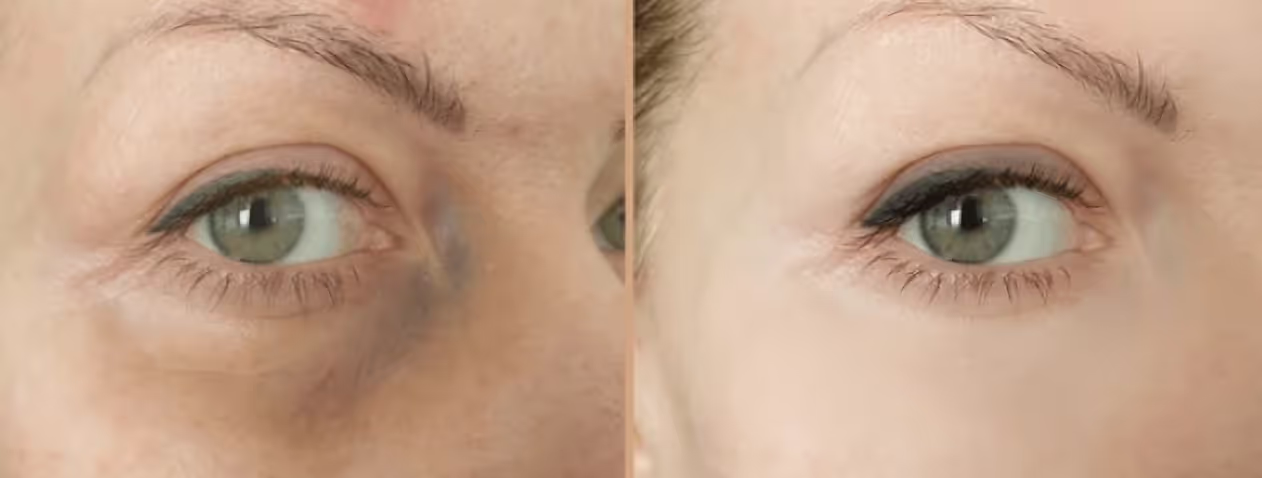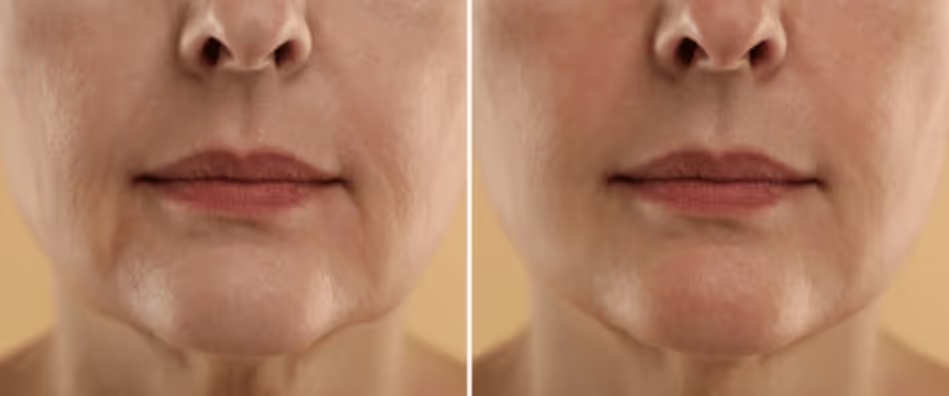What is Facial Fat Grafting
As we age, the face gradually loses volume—not just in the skin, but in the deeper fat pads and even the bone. Hollow cheeks, tired eyes, and fading contours can make us look older or more fatigued than we feel. Facial fat grafting offers a natural way to restore that lost fullness using your own tissue.
Also known as autologous fat transfer, this technique involves harvesting fat from areas like the abdomen or thighs, processing it carefully, and injecting it into specific zones of the face. The goal is to restore youthful shape and balance—not just to fill lines, but to rebuild underlying support. Unlike fillers, fat grafting also offers regenerative benefits, thanks to stem cells and growth factors naturally present in adipose tissue.
It can be performed on its own or combined with other procedures such as eyelid surgery, facelift, brow lift, or laser resurfacing.
What Can Be Treated with Facial Fat Grafting
Facial fat grafting is used to correct both age-related volume loss and contour irregularities caused by trauma, weight loss, congenital conditions, or prior surgery. Common treatment areas include:
- Hollow temples and forehead depressions
- Tear troughs and under-eye hollowing
- Midface deflation and flattened cheeks
- Nasolabial folds and marionette lines
- Thin lips
- Chin recession or jawline contouring
- Acne scars or surgical scars
- Facial asymmetry
In reconstructive cases, fat grafting is used for:
- Post-oncologic soft tissue defects
- HIV-related facial lipoatrophy
- Radiation damage
- Scarred or fibrotic tissue
Ready to Reclaim a More Youthful Look?
Browse trusted plastic surgeons who specialize in facial fat grafting near you.
Understanding the Anatomy of Aging
Facial aging is more than just skin sagging—it is a three-dimensional process involving multiple layers:
- Bone resorption reduces support around the eyes, cheeks, and chin.
- Fat compartments shrink and shift downward with age, especially in the temples, midface, and periorbital region.
- Ligaments weaken, allowing deeper structures to descend.
- The skin thins and loses collagen, elastin, and hydration.
Facial fat grafting addresses this by restoring volume in both deep structural planes and superficial compartments, reinforcing support and improving contour while also rejuvenating the overlying skin.
How the Fascial Fat Grafting Procedure Works
The procedure is performed in three steps:
1. Harvesting
Fat is collected using liposuction from areas such as the abdomen, flanks, or thighs. A tumescent solution is injected to reduce bleeding and trauma. The fat is gently suctioned using a blunt cannula under low pressure to preserve cell viability.
2. Purification
Harvested fat is processed to remove excess fluids, oil, and damaged cells. This can be done via:
- Centrifugation (e.g. 3000 rpm for 3 minutes)
- Filtration using mesh or sterile gauze
- Sedimentation (gravity separation)
Only the middle layer (viable fat) is retained for grafting.
3. Injection
The purified fat is injected in micro-aliquots (0.1 mL or less) using small cannulas. The fat is layered into different depths—deep subcutaneous, submuscular, or even on bone—depending on the target area. Careful distribution across multiple planes helps ensure natural results and optimal graft survival.
A slight overcorrection is often done to compensate for anticipated fat resorption.

Facial Zones & Injection Strategies
Different facial areas require tailored approaches:
- Forehead & Temples: Treated in subgaleal or submuscular layers; entry via hairline or lateral brow. Hollows may require 5–15 mL per side.
- Glabella & Nose: High-risk zone for vascular occlusion. Only performed with extreme caution, in very superficial planes.
- Tear Troughs: Fat is placed deep to the orbicularis oculi to avoid visible lumps. 0.5–1 mL per side is typical.
- Cheeks & Midface: Fat placed in the deep medial cheek and SOOF restores projection and lift.
- Nasolabial Folds & Marionette Lines: Superficial fat placed with fanning technique; not too deep to avoid bulkiness.
- Lips: Fat is injected in small threads into submucosa or orbicularis oris. Technique-sensitive area with higher resorption.
- Chin & Jawline: Treated in preperiosteal and subcutaneous layers to enhance definition and support sagging jowls.



Microfat vs. Nanofat
In facial fat grafting, the fat can be processed into different consistencies depending on the treatment goals.
Microfat contains living, intact fat cells. It’s used to restore volume in areas like the cheeks, temples, lips, and jawline. Once injected into deeper layers of the face, the fat blends naturally with surrounding tissue and can provide long-lasting structural support.
Nanofat, on the other hand, is made by emulsifying and filtering the fat until only liquid remains. This processed fat no longer contains viable fat cells, so it won’t add volume. Instead, it’s rich in stem cells and growth factors that help rejuvenate the skin. Nanofat is injected very superficially and is used to improve texture, tone, fine lines, and even help fade scars or pigmentation.
Some surgeons combine both techniques in the same session—using microfat for volume and nanofat to refresh the skin’s surface.
Benefits of Facial Fat Grafting
- Long-term volume: Surviving fat integrates into facial tissues and lasts for years.
- Natural results: Look and feel more like real facial fat than fillers.
- Regenerative effects: Improves skin texture and elasticity via growth factors.
- Biocompatibility: No risk of allergic reaction.
- Global rejuvenation: Ideal for patients with widespread volume loss.
Previewing Results Before Committing
Some surgeons offer a temporary saline injection to simulate the volume effect before committing to fat grafting. Others may recommend trying hyaluronic acid fillers in selected areas (like the midface or lips) as a reversible preview. These options can help patients feel more confident before undergoing a permanent transfer—but they are not perfect predictors, as fat behaves differently and integrates into tissue over time.
Find a Surgeon You Can Trust
Explore our directory of certified experts offering fat transfer procedures with natural, lasting results.
Face Fat Grafting vs. Fillers vs. Implants
Fat Grafting
- Uses your own fat, harvested from another part of your body
- Long-lasting results once the fat integrates (often 5+ years)
- Improves skin quality thanks to stem cells and growth factors
- Not reversible — excess fat can’t be dissolved
- Ideal for restoring volume across larger areas of the face
- Moderate downtime (about 1–2 weeks of swelling/bruising)
- Requires surgical expertise and sterile handling
- Made from synthetic substances like hyaluronic acid
- Results last 6 to 18 months, depending on the product and area
- Very precise and excellent for small corrections (e.g., lips, fine lines)
- Reversible with an enzyme (hyaluronidase)
- Minimal downtime — usually just a day or two
- Easier to fine-tune and adjust over time
Facial Implants
- Made from solid materials like silicone or Medpor
- Provide permanent structural enhancement (e.g., chin, cheekbones)
- Do not improve skin quality
- Require surgery and involve longer recovery
- Once placed, changes require another surgical procedure to adjust or remove
- Best suited for patients seeking strong definition in fixed areas
Still Have Questions?
Connect with experienced providers and get personalized advice about fat grafting and facial rejuvenation.
Realistic Expectations & Technique Nuance
Most experienced surgeons intentionally overfill slightly during the procedure, knowing that some of the fat will naturally resorb in the first few months. However, excessive overfilling—especially in mobile areas like the lips—can lead to bulky or unnatural results. Skilled fat grafting is about balance: precision, restraint, and proper placement are key to natural-looking rejuvenation.
Expected Results and Longevity
After facial fat grafting, patients typically experience swelling and bruising for about one to two weeks. The most noticeable changes appear within the first month, but final results take longer to settle. This is because a portion of the transferred fat—often between 30% and 50%—is naturally reabsorbed by the body over the first 3 to 6 months. The fat that survives becomes living tissue, integrating into the face and behaving like your own native fat.
Results continue to refine gradually, and by month four to six, the outcome is usually stable. Many patients choose to return for a small touch-up around six to twelve months later, especially in areas that are more dynamic or mobile, like the lips or nasolabial folds.
How long the results last depends on several factors. Technique and surgical expertise play a major role, as does the specific area treated—fat tends to survive better in deeper, less mobile zones like the cheeks or temples. Patient-related factors such as smoking, thin skin, and excessive facial movement can reduce fat retention. Once the fat has fully settled, the results can last for many years and often age gracefully along with the patient.
Disadvantages of Facial Fat Grafting
Despite its many benefits, facial fat grafting is not without limitations:
- Unpredictable fat survival: A portion of the fat (typically 30–50%) may be reabsorbed.
- Not reversible: Unlike fillers, fat cannot be dissolved—revision requires surgery.
- Touch-ups often needed: Especially in delicate or highly mobile areas like the lips or tear troughs.
- Longer downtime: Swelling and bruising may persist for up to 2 weeks.
- Technical sensitivity: Requires precision and anatomical knowledge to avoid complications.
- Risk of embolism: In very rare cases, fat entering a vessel can lead to blindness or stroke.
- Not suitable for all patients: Lean individuals may lack sufficient donor fat; smokers have lower graft retention.
Success Rate of Facial Fat Grafting
Facial fat grafting is considered highly successful when performed correctly:
- Fat survival rates range from 40% to 70%, depending on the area and technique.
- Patient satisfaction is generally high — studies report success rates between 70–90%, particularly for midface and cheek augmentation.
- Complication rates are low — under 2% in large clinical reviews, with most issues being minor and manageable.
- Once engrafted, the fat is stable and does not migrate or dissolve like synthetic fillers.
Facial fat grafting is one of the most versatile and effective techniques for restoring youthful facial structure and improving skin quality. It offers long-lasting, natural-looking results with the added benefit of tissue regeneration. While the procedure requires surgical skill and comes with some unpredictability, it remains a preferred choice for patients seeking a holistic, long-term solution to facial aging.
For those with realistic expectations and suitable anatomy, autologous fat transfer can be an excellent alternative—or complement—to synthetic fillers or facial implants.
Cost of Facial Lipofilling in Belgium
The cost of facial lipofilling starts at €3,200. This usually includes the plastic surgeon’s fee, clinic or hospital charges, anaesthesia, and initial follow-up visits. The exact price may vary depending on the complexity of the procedure and whether it is combined with other treatments.
Ready for Subtle, Long-Lasting Results?
Discover skilled surgeons in Belgium offering autologous fat transfer — and see what’s possible for your face.


